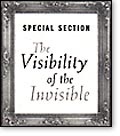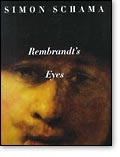Catharine Randall
The Visibility of the Invisible: Rembrandt's Protestant Icons

Special Section

Rembrandt's Eyes
Rembrandt's Eyes, by Simon Schama, Alfred A. Knopf, 1999, 701 pp.; $50
In the film The Madness of King George, the Puritan pastor charged with monitoring and rectifying the conduct of the crazed George III says to him firmly, ominously, "I have you in my eye, Sir. I shall keep you in my eye." This minatory Puritan takes on a role most Protestants reserve for themselves: keeping an eye on the self. In fact, such self-gazing represents a somewhat paradoxical Reformed obsession.
Reformed theology mandated a focus on the divine, not on the human subject. Yet the need for keeping a constant watch over the potentially vagrant self, fashioned of fallen nature, led many Reformed believers to concentrate increasingly on policing their own inner states: precisely because the self is sinful and wants too much attention, one must gaze vigilantly inward in order to keep the self down and out of trouble. This incessant tracking of possible shortcomings and pitfalls could blur the necessary focus on divine grace.
The distinctively Protestant focus on the self exercised enormous influence in Europe and North America, and not only among Protestants. It was certainly one of the formative influences on the vibrant Dutch culture of the seventeeth century and on the greatest artist that age of great art produced: the painter Rembrandt, the subject of a massively ambitious, richly textured study by the historian Simon Schama. With The Embarrassment of Riches: An Interpretation of Dutch Culture in the Golden Age, Schama established him self as an expert on early modern Dutch culture. In subsequent works he challenged the conventions of academic history, essaying novelistic speculation. Here, he extends his metier to that of art critic.[1]
"Rembrandt," Schama tells us, "was one of nature's ecumenicals. His mother's family had been Catholic; his father's desultorily Calvinist." Rembrandt himself showed no inclination to pledge confessional allegiance—"which is not to say," Schama adds, "that Rembrandt did not feel his faith as intensely as Rubens did his."
But while Schama is careful not to call Rembrandt a Protestant, he acknowledges the impact of Reformed thought on Rembrandt's painterly scheme. Although all painters of the time, Catholics as well as Protestants, explicated biblical themes, Rembrandt's works in this genre tend to display an especially Pauline influence, an influence most closely associated with the emergence of Protestant theology. His 1638 The Fall of Man shows Adam and Eve in an amalgam of prelapsarian heedlessness and postlapsarian consciousness, demonstrating original sin and the depravity of the human will. Almost bestial in representation, both Adam and Eve show the marks of shame. The painting Susanna and the Elders as well as the etching Joseph and Potiphar's Wife are very graphic in sexual depiction, drawing the viewer in as voyeur, heightening that prototypically Protestant sense of the lure of sin.
Rembrandt's preoccupation with self has a special energy in that he is fascinated by themes of blindness, sightedness, insight, scrutiny, and revelation. A profoundly self-absorbed individual, Rembrandt nonetheless had the capacity to become absorbed in the costuming of the subjectivity of others, especially as it revealed the tension between public self-presentation and private self. Schama reads Rembrandt's masterly Portrait of Jan Six (1654) as displaying just such a tension. In a stunning analysis, Schama concentrates on Six's gloved left hand. While viewers tend to assume that Six is pulling his glove on, preparatory to going out, Schama reads the fine detail and finds that the thumbnail is depicted as tightly pressed against the chamois so that, in fact, Six's hand must already be firmly in the glove, and he is removing it, prior to resuming his inner, and indoors, persona. This interplay of inner and outer reveals a complexity of self-presentation that a less sensitive observer would have missed and is also consonant with the Protestant discomfort with disjunction between appearance and being.[2]
The Reformed emphasis on the preeminence of God's Word inspired and challenged Rembrandt as well: here the energizing tension is between word and image. The Calvinist pastor in the Portrait of Johannes Cornelisz Sylvius (1646), for example, protrudes over the edge of the frame sketched around his image, as though to show the power of his expository word—reflection of divine Verbum—to cross boundaries and make contact. The image becomes a motor, a dynamism for the display of verbal potency rather than figurative exactitude. Drawn to the Mennonite sect by his own religious inclinations, Rembrandt's sensitive Portrait of Cornelis Claesz. Anslo and His Wife, Aeltje Gerritsdr. Schouten (1641) confers gravity and dignity on the couple, while animating as if by divine breath the pages of the Bible they consult. The real energy here, Rembrandt seems to say, is verbal and is generated by the self dwelling on the Word. Schama concludes that "Rembrandt … could make the things of this world hymn the sanctity of the world to come, yet manage, somehow, not to trespass impiously across its borders. He had created what the preachers had said was impossible: Protestant icons."
The spotlight on the self, and its good or bad choices, is reinforced by Rembrandt's emphasis on subjectivity. Schama excels in progressively displaying a veritable portrait gallery of Rembrandt's self-depictions, examining their evolution over time and what they have to say about the painter's character and position in the world. He notes, for in stance, in The Artist in His Studio (1629) that the artist's eyes are deeply shadowed, almost blacked out, as though he were wearing a mask. Rembrandt, on the threshold of his career, has not yet devised his own identity: hence, the eyes reveal an emptiness to be filled. But this vacuity is not negative; rather, Schama sees the painter posing as the very emblem of imagination or ingenuity, as Painting's own copious powers of invention, yet to be unfurled. Schama observes that Rembrandt's focus on eyes in all the portraits is a brilliantly simple rehearsal of draftsman techniques: "when the student, child or adult, was given an exercise in drawing a specific feature of the physiognomy, first and always came the eye."
The material quality of Rembrandt's settings and backgrounds—so vividly evoked by Schama's lustrous verbal images—may also have a Protestant derivation. In Sources of the Self, philosopher Charles Taylor compellingly argued that one reason for the strength of Reformed faith was its willingness to explain Scripture using events drawn from quotidian existence, to elevate the ordinary occupations exercised by believers in the world to the status of a spiritual vocation. The world here-and-now possesses dignity. The Calvinist revolution in Holland, Schama observes, brought about the "replacement of a flamboyantly poetic manner with an unapologetically prosaic one; a coming down to earth."
Just so, Rembrandt's elaborate canvases, embroidered with detail like genre paintings run amok, offer a visually dazzling cornucopia of stuffs and substances, textures, implements, exotica, gadgets—compasses, astrolabes, butter churns, document boxes—some with symbolic valence or allegorical intent, but most present simply to authenticate lived experience and to enhance the pictorial illusion.
Schama details at great length the contents of Rembrandt's Wunderkammer, a large room filled with curiosities, a mammoth collector's cabinet jammed with unusual oddments, monstrosities, fragments of strange and wonderful objects. (In his book La Tulipe et la licorne, Antoine Schnapper has contended that the construction of Wunderkammerer was practiced chiefly, although not exclusively, by members of the Reformed faith.)
Paintings by Rembrandt displaying patriarchal roles or familial hierarchies often deal directly with a capstone of Protestant theology: the companionate marriage, both partners scripturally literate (or becoming so, as in An Old Woman Reading, 1631, almost certainly a representation of a pious Protestant) with the father as biblical exhorter and teacher of the wife and children. Relationships are developed through a textual filter: through proximity to the Bible, through discussion of Scripture, rather than through personal interaction per se. In Two Old Men Disputing (1628), the focal point of the microdrama is the text designated by the patriarch's finger. Light falls on several Bibles arrayed about the room, making the drama one of scriptural utterance rather than of character development. In addition, paintings like David at Prayer (1652) show the Protestant shift to a domestic interior as the space for piety, as opposed to the Catholic tendency to display acts of worship in a church or other designated "sacred" space.
In other ways, too, Rembrandt's canvases demonstrate a shift from Catholic to Protestant piety. Discussing the Portrait of Maerten Soolmans (1634), Schama digresses to tell us that in paired portraits of spouses, "often, the man … may hold a pair of gloves, the emblem of the dextrarum iunctio, of the nuptial joining of right hands, a detail which, in Catholic culture, had originally signified the sacramental nature of marriage, but which had survived into seventeenth-century Protestantism as a symbol of the marital bond." Where as visual props had been used symbolically, or allegorically—a tendency more often associated with Catholic schemas—Rembrandt uses them as indicators of relationships and of nuanced subjectivities.
Finally, there's a degree of irony in considering the Reformed influence on Rembrandt's prodigious artistic output. Calvinists notoriously had a problem with the notion of creativity. God the Creator had created once and for all, and all further expression should be a mere gloss on his perfect order. For this reason, for example, both Calvin and Beza decried the writing of fiction as a hubristic attempt to supplant God by inventing one's own universe; after all, the Latin root of fiction, fingere, meant lying.
Rembrandt, as creator of his canvases, is drawn to heroicized characters in strong, authorial roles, yet also shows some ambivalence toward these postures. In The Anatomy Lesson of Dr. Tulp (1632), he depicts the sage surgeon designating with his scalpel the flayed musculature of a corpse's arm and making a pedantic oval with his first finger and thumb to underscore the point of his lecture. A sort of "moral drama," rather than simple anatomy illustration, emerges from Rembrandt's rendering, since the corpse, rather than receding into the shadows, has half light on his face, forcing us as viewers to deal with the body as still a person—and requiring us to acknowledge our own mortality. Dr. Tulp's surgical wisdom, perhaps paraded a trifle arrogantly, yields to the recognition of a supreme Creator behind the dissecting theater. That is a lesson of which Calvin himself presumably would have approved.
Catharine Randall is professor of French and chair of the Department of Modern Languages at Fordham University. Her most recent book is Building Codes: The Calvinist Aesthetics of Early Modern Europe (Univ. of Pennsylvania Press).
Footnotes:
1. The historian's novelistic bent is indulged in Rembrandt's Eyes as well. What Schama himself calls "a conjectural biography" is both winsome and vexing. The overlay of "must have," "perhaps," and "suppose" grows too thick at times and seems distorting. The correlate of this device is a sometimes too obvious ploy to insert the reader: "How would you have felt?" Schama asks, apparently imploring acquiescence rather than hoping for intellectual assent to irrefutable logic.
2. Since Schama makes so much of notions of selfhood, he might well have begun with how identity was understood in the seventeenth century—certainly quite differently from our fractured, postmodern self-conceptions. Because he does not, some degree of his own projection is inevitable; more than a hint of Freudian psychoanalytical vocabulary shades Schama's perspective.
NOTE: For your convenience, the following product, which was mentioned above, is available for purchase:
• Rembrandt's Eyes, Simon Schama
Copyright © 2001 by the author or Christianity Today/Books & Culture Magazine.
Click here for reprint information on Books & Culture.








No comments
See all comments
*